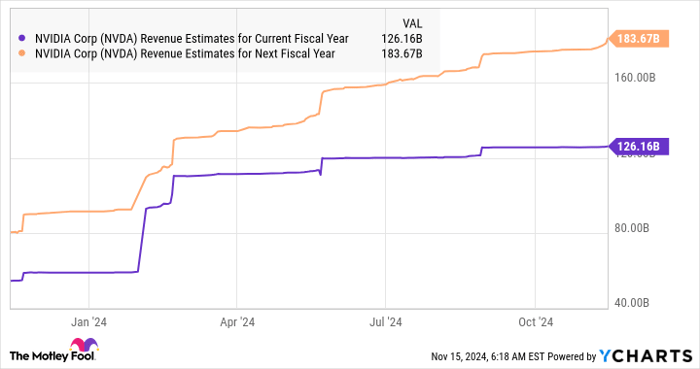Nvidia Stock Has Done This After Its Last Four Quarterly Results. Here's What It May Do After Nov. 20


Nvidia (NASDAQ: NVDA) stock's stellar rally is set to be tested when the semiconductor giant releases its fiscal 2025 third-quarter results (for the three months ended Oct. 27) on Nov. 20, as investors and analysts will be expecting the chipmaker to continue its artificial intelligence (AI)-fueled surge.
After all, shares of Nvidia have shot up a remarkable 196% so far in 2024, as of this writing, and they command a rich valuation. In this article, I will take a look at how Nvidia stock has performed following the release of its previous four quarterly results before checking what lies in store for investors when it releases its next set of results.
Investors' reaction to Nvidia's results has been mixed in the last four quarters
The following chart summarizes the market's immediate reaction to Nvidia's previous four quarterly reports.
Date | Period | Revenue (in $billion) | Year-over-year change | Earnings per share | Year-over-year change | Immediate stock price change |
|---|---|---|---|---|---|---|
Nov. 21, 2023 | Q3 FY2024 | $18 | 206% | $4.02 | 593% | -2% |
Feb. 21, 2023 | Q4 FY2024 | $22 | 265% | $5.16 | 486% | 16% |
May. 22, 2024 | Q1 FY2025 | $26 | 262% | $6.12 | 461% | 9% |
Aug. 28, 2024 | Q2 FY2025 | $30 | 122% | $0.68 | 152% | -6% |
Source: Nvidia's quarterly earnings releases and Yahoo! Finance historical price data.
When Nvidia released its fiscal 2024 Q3 results a year ago, the stock fell thanks to concerns about the company's business in China on account of restrictions by the U.S. government on exports to the country. The market overlooked the company's better-than-expected results and impressive guidance at that time.
However, the next two quarterly reports gave Nvidia stock a nice boost as the company continued its string of healthy growth in revenue and earnings thanks to the solid demand for its AI graphics processing units (GPUs). However, when Nvidia released its previous quarterly results in August this year, investors seemingly took issue with the relatively slower pace of growth that the company reported.
It is worth noting that Nvidia's revenue growth in the second quarter of fiscal 2025 was a deceleration over the growth that it delivered in the previous three quarters. Of course, the company did more than double its revenue on a year-over-year basis, and its earnings also surged impressively, but Wall Street had gotten used to much stronger growth in its top and bottom lines by that time.
On top of that, Nvidia guided for fiscal Q3 revenue of $32.5 billion, which would translate into a year-over-year increase of almost 80%. So, the chipmaker's guidance indicates that its top line won't be doubling from the year-ago period when it releases its results on Nov. 20. However, the bigger picture is that Nvidia stock has tripled in the past year after taking into account the immediate fluctuations in price following its quarterly results.
That's not surprising, as the recent market developments have made it clear that the company continues to remain the dominant player in AI chips, a market that's showing no signs of slowing down. Investors, therefore, would do well to focus on the bigger picture when Nvidia releases its quarterly report.
Here's what the bigger picture looks like
The relative slowdown in Nvidia's growth from the prior quarters is logical, considering that the company now has a much higher revenue base. Even then, an 80% jump in quarterly revenue is no mean feat, especially considering that rivals such as AMD have found it difficult to make a notable dent in the AI chip market and are having difficulty taking share away from Nvidia.
For example, AMD's revenue in the third quarter of 2024 was up 18% year over year to $6.8 billion. The company's data center business recorded a year-over-year jump of 122% in revenue to $3.5 billion. That pales in comparison to the 154% year-over-year increase in Nvidia's data center revenue in fiscal Q2 to a massive $26.3 billion.
In other words, Nvidia is growing at a faster pace than AMD despite having a larger revenue base. That's because the company is the leading supplier of AI chips, with a market share of as much as 95%. More importantly, that dominance seems set to continue as the demand for Nvidia's new generation of Blackwell AI processors is set to exceed supply in 2025, which is not surprising as these chips are expected to maintain their technological advantage over AMD's offerings.
Analysts are upbeat about the sales of Nvidia's Blackwell processors, with a report by Morgan Stanley (via Tom's Hardware) suggesting that the company could sell $200 billion worth of these chips next year. If that indeed happens, Nvidia's revenue in the next fiscal year could turn out to be well ahead of expectations.
NVDA Revenue Estimates for Current Fiscal Year data by YCharts
As per the above chart, Nvidia's top line is expected to more than double in fiscal 2025 from last year's reading of $60.9 billion. Analysts are forecasting another jump of 43% in its revenue next fiscal year, but the strong demand for Blackwell could help it exceed that mark handsomely.
So, if Nvidia delivers a better-than-expected outlook for the current quarter on account of the successful launch of its Blackwell processors, it could set the stage for more upside in this AI stock even after the terrific gains it has clocked this year.








